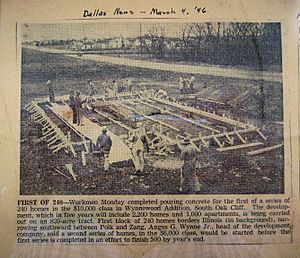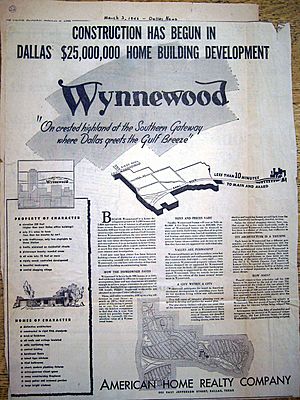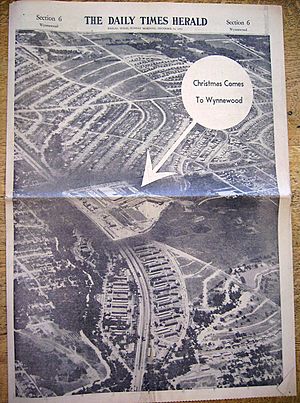Wynnewood, Dallas facts for kids
Wynnewood is a big neighborhood in Oak Cliff, which is a part of Dallas, Texas. It covers about 820 acres (3.3 square kilometers). Long ago, Wynnewood was known for its buildings that had beautiful old wooden floors. In the late 1950s, the United States Air Force used a building in Wynnewood. They had a "Filter Center" there to track airplanes and even tornadoes in a huge area.
Contents
History of Wynnewood
The story of Wynnewood is linked to how suburbs grew after World War II. Wynnewood is like Levittown, New York, another planned community built around the same time. Both were named after the families or companies that built them.
The land for Wynnewood, about 820 acres (3.3 square kilometers), was bought in 1913. But it stayed empty until the 1940s. Then, Toddie Lee Wynne, Sr., and Benjamin Hick Majors bought the company that owned the land. When Wynne's nephew, Angus Gilchrist Wynne, Jr., came back from the war, he became the company's president. His job was to build new homes because many people needed them after the war.
Building started in March 1946. The first homes were finished on Veasy Street, which is now called Wynnewood Drive. J. D. Jones was the first person to live in a Wynnewood home. Most of the neighborhood was finished by 1954.
Planning Wynnewood: A Special Community
Angus Wynne and his architect, Roscoe DeWitt, wanted Wynnewood to be "one self-contained community." An advertisement even called it the "City of Wynnewood, U.S.A." It was not a city that grew slowly over time. Instead, it was carefully planned by its creators.
Wynnewood was designed to have 2,200 homes and 1,000 apartments. A large shopping area was placed right in the middle. The homes cost between $6,000 and $20,000. This included smaller homes and bigger, more expensive ones in Wynnewood North. Having different types of homes meant people with different incomes could live there. At first, only white families were able to live in the community.
Wynne and DeWitt tried to build many homes quickly while still making them look unique. Homes in Wynnewood do not all look the same. They have different styles and layouts. But they were built very efficiently. Parts of the homes were made in special factories.
The builders also focused on good quality work. For example, the electrical wiring in the homes was made to handle many appliances.
Many streets in Wynnewood are named after World War II Navy leaders, ships, and battles. This is because Angus Wynne was in the Navy. DeWitt Circle is named after the architect.
Wynnewood Shopping Center: A Hub for the Community
Unlike some modern neighborhoods, Wynne and his team planned a big shopping center. It was right in the middle of their community. Building started in 1947. By 1954, the Wynnewood Shopping Village had grown to 150 shops. It covered 53 acres (21 hectares) and had 6,400 parking spaces.
The shopping center had a movie theater and a post office. There was also a bank, department stores, and grocery stores. You could find drugstores, restaurants, and furniture shops. There were even doctors' offices and a hotel. What makes the Wynnewood Shopping Center special is its "village" style. Shops are in one-story buildings with trees around them, not all crammed into one big indoor mall.
Wynnewood Now: What's It Like Today?
Over the years, Wynnewood has changed. It has lost some of the special feeling its founders hoped for. But many people in Wynnewood North still work to keep their neighborhood unique. Wynnewood is still one of the most diverse neighborhoods in Dallas. People from different backgrounds and incomes live there now. The homes are still strong, just as they were promised. The streets, lined with trees, feel peaceful and comfortable. The apartments have become affordable housing, which has brought some new challenges.
One sad part of Wynnewood's recent history is its shopping village. It is not as busy as it used to be. Many buildings have been torn down. The Professional Building, movie theater, hotel, and department stores are all gone. People have talked about making the shopping center better. The community still needs its services. But as of 2008, nothing had happened with these plans.
Images for kids













